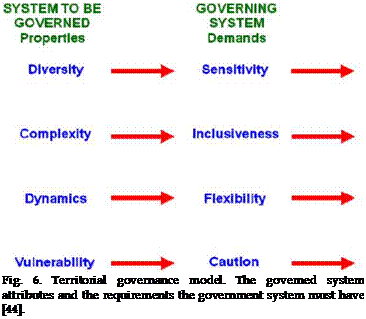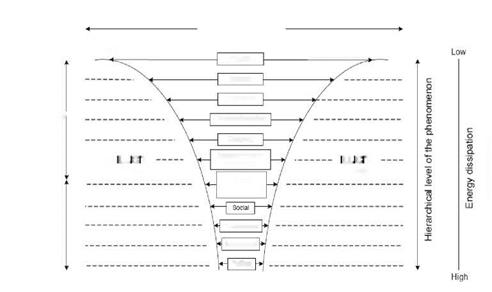Governance refers to the art and the way of carrying out government, as well as, the executive action. Governance emerges based on the general request for the administration of: natural resources, world ecosystems and territory development. It should be allowed an antrophic control of the phenomena. Governance improves public policies and collective actions to solve problems and take care of the integral development. Nevertheless, it is not possible to predict the future cultural landscape but to simulate and evaluate further scenarios [30]. Some handling capacity can be developed in order to shift to a more specific and desirable situation for a particular culture and stakeholder.
Jentoft [44] states that territorial governance is basically a relationship between two systems: the government system and the governed system. The first is a structure of institutions and control mechanisms. The second is partially social and partially natural: it consists in one ecosystem coupled with its resources, as well as stakeholders, all of them developing institutions and political conditions. Territorial government is related to the connections of both subsystems, by integrating them into only one. In order to make operative governance, both systems should be mutually sensible, combined and coevolving [40].
Jentoft [44] has developed a governance model, where both systems (government and governed) should be efficient (Figure 6).
 GOVERNING
GOVERNING
SYSTEM
Provisions
Contextualizing
Coordinating
Learning
Safe-guarding
An ecosystem service is a basic element for the territorial sustainable governance that supports life on earth and takes care of the diversity of those services within a varied cultural landscape [74, 75]. These services are necessary for human survivorship and social development [1, 2, 13, 76]. Since ecological services are not tradable in financial markets,
there is a shortage of regulatory mechanisms to detect the supply and ecosystem damage [2, 74, 75, 77-79]. Human economy can’t operate without ecosystem services, and thus, the financial value is infinite. Constanza et al. [74] present seventeen categories of ecosystem services: gas regulation, climatic regulation, disruption regulation, hydric regulation, water supply, erosion control, soil formation, nutrient cycle, waste treatment, pollination, biological control, shelter, food production, raw materials, genetic resources, recreation, and culture.
 It is amazing to notice that conventional productive agriculture only generates two of those seventeen categories: food and raw materials. What is more, the green revolution of industrial agriculture has a negative effect on the other fifteen. However, it’s important to mention that rurality is concerned about all seventeen ecological services.
It is amazing to notice that conventional productive agriculture only generates two of those seventeen categories: food and raw materials. What is more, the green revolution of industrial agriculture has a negative effect on the other fifteen. However, it’s important to mention that rurality is concerned about all seventeen ecological services.



